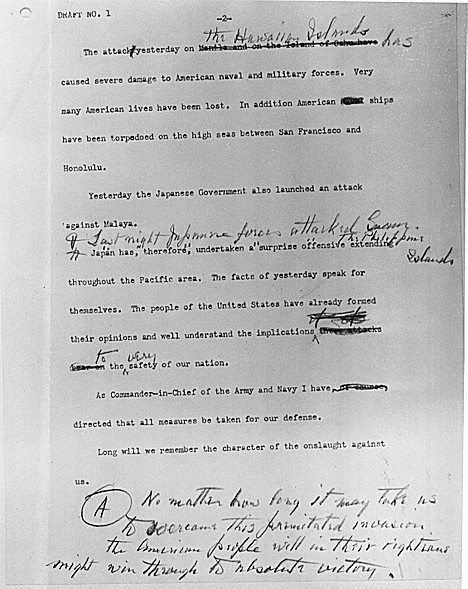Washington, DC…80 Years ago today was the surprise attack on Pearl Harbor. This attack threw the US fully into WWII. In this piece we would like to feature FDR’s crafting of his “Date which will live in Infamy” speech that was delivered to Congress on December 8, 1941. From the National Archives & FDR Library…”Early in the afternoon of December 7, 1941, President Franklin D. Roosevelt and his chief foreign policy aide, Harry Hopkins, were interrupted by a telephone call from Secretary of War Henry Stimson and told that the Japanese had attacked Pearl Harbor. At about 5:00 p.m., following meetings with his military advisers, the President calmly and decisively dictated to his secretary, Grace Tully, a request to Congress for a declaration of war. He had composed the speech in his head after deciding on a brief, uncomplicated appeal to the people of the United States rather than a thorough recitation of Japanese perfidies, as Secretary of State Cordell Hull had urged.
President Franklin D. Roosevelt Signing the Declaration of War against Japan December 8, 1941
President Roosevelt then revised the typed draft—marking it up, updating military information, and selecting alternative wordings that strengthened the tone of the speech. He made the most significant change in the critical first line, which originally read, “a date which will live in world history.” Grace Tully then prepared the final reading copy, which Roosevelt subsequently altered in three more places.
On December 8, at 12:30 p.m., Roosevelt addressed a joint session of Congress and the Nation via radio. The Senate responded with a unanimous vote in support of war; only Montana pacifist Jeanette Rankin dissented in the House. At 4:00 p.m. that same afternoon, President Roosevelt signed the declaration of war.
The document featured in this article, the typewritten draft, is housed at the Franklin D. Roosevelt Library in Hyde Park, NY.”






